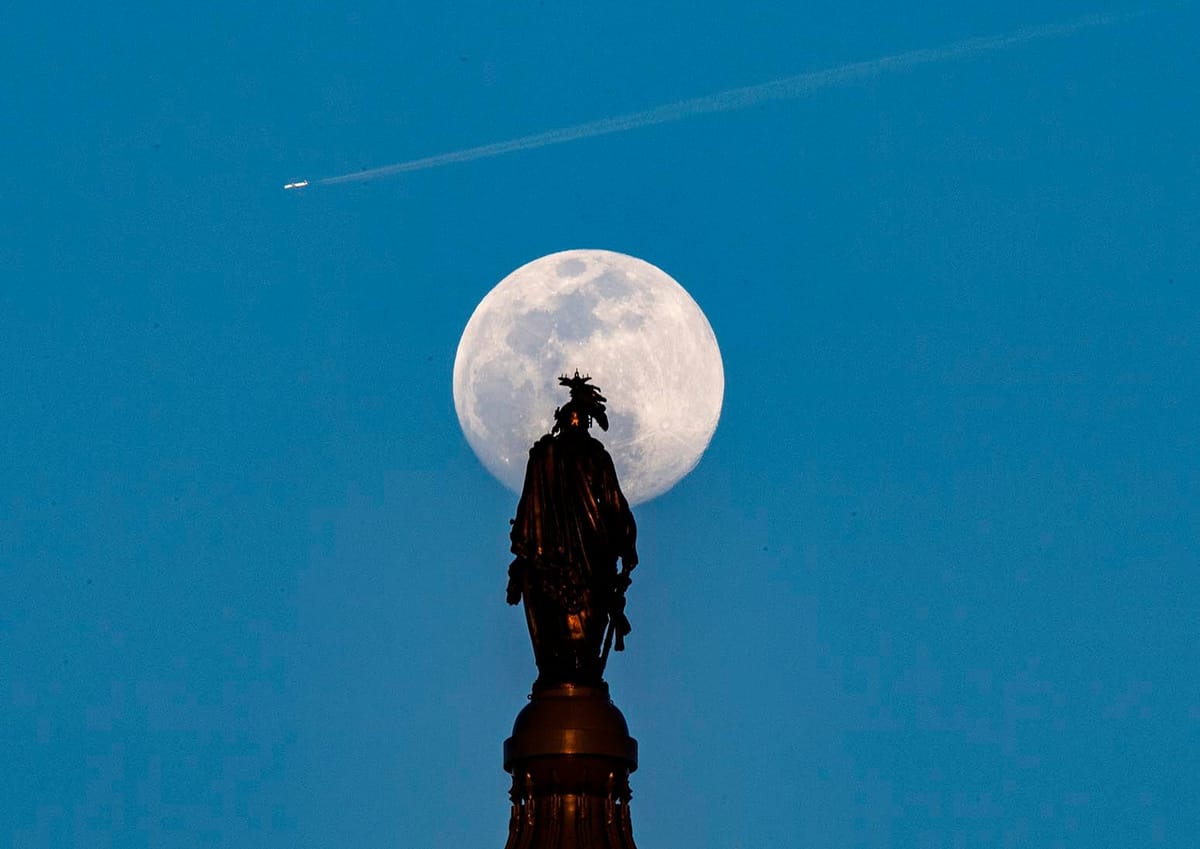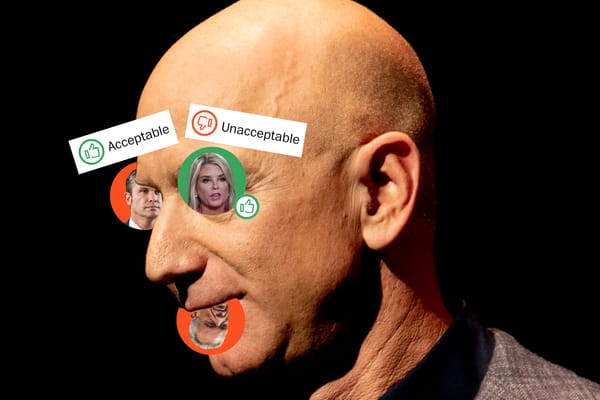Indignity Vol. 2, No. 37: Rights are for everyone.
GENDER STUDIES DEP'T.

What Defines Abortion as a Women's Issue?
WHO GETS ABORTIONS? As soon as the news broke that the Supreme Court plans to overturn Roe v. Wade, people began bickering—or preemptively trying to get the bickering going—about what language to use in discussing it.
"If we have 'pregnant people' then how can Roe be about 'a woman’s right to choose'?" Sen. Marco Rubio tweeted. Rubio does not, of course, believe that a woman has a right to choose. The point behind his taunt was simply that, at the very moment the Supreme Court was preparing to end the right of women to get abortions, there were also discussions and arguments long underway about whether using the word "women" in the context of abortion, and in various other contexts, is sufficient and accurate.
His point was stupid, and mostly irrelevant. The people who advocate trans rights and who ask people to use language that reflects the existence of trans people—some of whom do, after all, get pregnant or need gynecological care while not identifying as "women"—tend not to fly off the handle when other people talk about women's need for access to abortion. The Trans Journalists Association's guidelines on the subject encourage the use of "patients" or "people," or phrases like "women and other abortion patients," and note that using "phrases like 'birthing people,' 'people with uteruses' and the like" as replacements for "women" can be offensive.
But people want to be offended, or at least to say they're offended, especially when they see a chance to reverse other people's notions of what counts as an offense. This is what led to the spectacle of Republicans on the Senate Judiciary Committee demanding that Ketanji Brown Jackson—under a nomination that would make her the first Black woman on the Supreme Court and would bring the ratio of men to women on the court below two to one—define for them what the word "woman" meant.
And it's what led other people, strung out along the spectrum from tentatively heterodox liberals to full-on reactionaries, to join Rubio in clambering on top of the ruins of a half-century's worth of abortion rights jurisprudence to air their momentary complants about the politics of gender identity. "Absent from the Washington Post's editorial on the draft abortion ruling: the word 'women,'" the journalist Alec MacGillis tweeted, to the eager retweets of an assortment of anti-"wokeness" and outright anti-trans personalities.
It was true that the Post's editorial board had avoided using the word "women." That was not the point of the editorial, which was written to denounce the apparently upcoming overturning of Roe as "a grievous blow to freedom in the United States — and to the legitimacy of the court itself." But if a reader were inclined to, they could certainly stumble over the clunky use of "pregnant individuals" in the text.
When I read the editorial, though, the effect that stuck with me was something else entirely. "[T]he Constitution," the Post's editors wrote, "guarantees Americans the right to end their pregnancies." And: "the Constitution’s guarantees of personal autonomy demand that pregnant people be able to make the difficult decision about whether to end their pregnancy according to the dictates of their own conscience."
It was an unfamiliar way to see those ideas expressed. But the unfamiliarity extended beyond the lens of trans rights, to the fundamental terms of the abortion discussion. The right to end a pregnancy, the editorial was saying, belongs to Americans. It was not describing it as something belonging to women, but as something universal. It was arguing that the people who need abortions are people, and that their rights as people are at stake.
This is not how anyone usually talks about abortion in the United States. Abortion has been a women's issue, and women's issues are treated as a bolt-on addition to the issues that belong to everyone. Thus it was Hilary Clinton who was challenged in a presidential debate to justify her support of Planned Parenthood and to defend abortion—including "partial birth abortion," as the moderator, Chris Wallace, chose to call it. "The government has no business in the decisions that women make with their families in accordance with their faith, with medical advice," Clinton replied.
Even with those caveats about family and faith woven in, it was a startlingly frank statement of a principle that her party prefers to soft-pedal. There was nothing to compare to it four years later, when Joe Biden—running for the same party, on the same basic platform—took his turn against Trump on the debate stage.
Trump was then in the midst of appointing Amy Coney Barrett, dramatically fulfilling his pledge from the Clinton debate that he would put "two or perhaps three" anti-abortion justices on the court, which he had predicted would "automatically" end Roe. When Biden brought up that Trump was against Roe v. Wade, Trump countered that Biden didn't know what Barrett's position on Roe was, and the moderator—Wallace again—let that claim go, then went on to ask Biden not about abortion but about the filibuster. The substance of abortion rights, or even the word "abortion," never came up.
These limits, and a whole world of others, on our culture and politics—on abortion rights and trans rights alike—are drawn around the subjugation of women, and men's dread of and contempt toward women's bodies. Naming that fact is crucial. Jill Lepore was doing essential factual and rhetorical work when she wrote in the New Yorker, in response to Alito's argument that the constitution doesn't mention abortion:
There is nothing in that document about women at all. Most consequentially, there is nothing in that document—or in the circumstances under which it was written—that suggests its authors imagined women as part of the political community embraced by the phrase “We the People.” There were no women among the delegates to the Constitutional Convention. There were no women among the hundreds of people who participated in ratifying conventions in the states. There were no women judges. There were no women legislators. At the time, women could neither hold office nor run for office, and, except in New Jersey, and then only fleetingly, women could not vote. Legally, most women did not exist as persons.
But the decision to talk about women's rights as being anyone's rights has its own logic. At least on the subject of abortion, the discourse seems to be in no immediate danger of being taken over by cynical people claiming they don't see sex or gender, the way the current chief justice of the Supreme Court rejects civil rights laws in the name of a color-blind country. To move the discussion into the universal, here, heightens the fact that the court is diminishing basic human rights.
There may not be one single approach that best expresses what Marie Shear called "the radical notion that women are people." The text of the Equal Rights Amendment has gone back and forth through its history. In its original proposed form, it read "Men and women shall have equal rights throughout the United States." The version that came to the brink of ratification replaced that with "Equality of rights under the law shall not be denied or abridged by the United States or by any state on account of sex."
The most recent House and Senate bills to restart the amendment diverge, with the Senate keeping the language of the previous version, while the House expands it, by preceding the "equality of rights" sentence with "Women shall have equal rights in the United States and every place subject to its jurisdiction."
Neither version, the explicitly gendered version nor the gender-transcending one, has passed. The constitution remains a text about "persons" or "parties," whose pronouns are "he," "his," and "himself." ("Male" crops up three times in the 14th Amendment, only to be nullified by the gender-neutralizing 19th.) What the Post's editorial did was to imagine a different default: a person is someone who may need an abortion.






![Screencap from the video, caption "[Toshiaki] Nice and chewy." Buldak Chicken Carbonara $1.38/pack](/content/images/size/w600/2025/01/ramen-chewy-2025-01-10-at-7.38.57-PM.jpg)